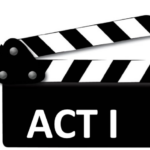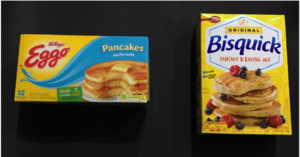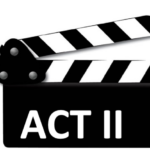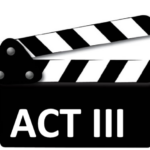Three-Act Math
By 2019 AE&L Conference Presenter
Jeffrey Elmore
This month in PROGRESS, we’re sharing items that we hope you’ll add to your instructor tool kits, so I wanted to be sure to include one of my math favorites. The tool is called “three-act math”.It’s an approach to mathematics instruction that follows the model of storytelling, originated by Dan Meyer. He offers plenty of information and lessons to share, but many others have contributed to this valuable tool. At the end of this article, I’ll include a few links to help you see what’s available.
Think about a compelling story, book, or movie. In act one, we are presented with a dilemma. The author wants us to be curious and have questions, giving us just enough information to be engaged. We see something of value, something that connects to us, or something that drives us to continue our inquiry. In a mathematics problem, this engagement and curiosity correlates with the College and Career Readiness Standards Math Practices of making sense of the problem and desiring to persevere through to a solution.

What would “Act I” look like in practice? Ratios and proportions are an important part of Major Work of the Level, so let’s use that as our content example. As well, we know that our students are budget conscious, so let’s leverage that! We need a visual prompt that, in a minimalistic manner, poses a question using something familiar.

Everyone can relate to pancakes, right? On the right, we have a box of pancake mix; on the left, we have frozen pancakes. Given this problem, the next step is for the students, in groups, to begin discussing the dilemma. We want our students to consider what information they have and what information they need. As instructors, we have anticipated some of the most common questions that could be asked or statements our students might make. Maybe we have the information to provide as it is requested, or maybe we ask our students to find what they need on their own. Once our student groups have asked the necessary questions and gathered information, it’s time for act two.
 “Act II” is the stage where students build the problem. They should really be making sense of it now, engaging in most of the Standards for Mathematical Practice. In their groups, the students should be reasoning both abstractly and quantitatively; using structure, tools, and patterns; and finally modeling with mathematics. For our pancake dilemma, we would expect the groups to be building ratios that compare the cost of the mix and the number of pancakes it could make with the cost of the frozen pancakes and the number of those in the box. We’d let them use their own means to build models that make sense to them. We’d want our student groups to explore questions associated with the problem, but it would be our responsibility as instructors to keep them from going too far off track. When our student groups have mathematical solutions that they are satisfied with and are ready to explain, it’s time for act three.
“Act II” is the stage where students build the problem. They should really be making sense of it now, engaging in most of the Standards for Mathematical Practice. In their groups, the students should be reasoning both abstractly and quantitatively; using structure, tools, and patterns; and finally modeling with mathematics. For our pancake dilemma, we would expect the groups to be building ratios that compare the cost of the mix and the number of pancakes it could make with the cost of the frozen pancakes and the number of those in the box. We’d let them use their own means to build models that make sense to them. We’d want our student groups to explore questions associated with the problem, but it would be our responsibility as instructors to keep them from going too far off track. When our student groups have mathematical solutions that they are satisfied with and are ready to explain, it’s time for act three.

“Act III” is the big reveal. In this third stage, our groups will provide their and models. It’s ideal if you have two or more groups who have arrived at the same solutions but have used different methods to arrive at those solutions. Part of your job as the instructor in “Act III” is to facilitate critical reflection on the process, allowing groups to correct any mistakes without too much help from you. The reflective activities should also bolster students’ confidence in their own mathematics abilities. Finally, act three should be a place where you set up the future. With the right environment, the students should be asking lots of “what if” questions. Maybe you are increasing complexity by adding your own “what ifs.” In the case of our pancake dilemma, we would want to have a comparison of the cost of one pancake, or maybe one serving of pancakes, for both the mix and the frozen pancakes. I would hope that somewhere along the line, for the pancake mix, someone would have recognized that the box itself is not the only cost—we also need milk to add to complete the batter and oil or butter to cook the pancakes! I’d also hope that someone would bring the convenience factor into the equation. The frozen pancakes may cost a bit more, but they will take a lot less time. What’s the value of our time? All of these thoughts should lead to a vigorous discussion of what exactly a “best deal” is and how mathematics can provide data to inform the answer. final answers and based on their work justify the answers.
I hope that this has given you some ideas about incorporating three-act math into your instructional toolbox! To give credit where it is deserved, my pancake dilemma example is an adaptation from Dane Elhert’s blog, When Math Happens.
As promised, here are a few links to help you get started with three-act math:
- The Three Acts of a Mathematical StoryBlog
- Dan Meyer’s Three-Act Math Tasks
- Tap Into Teen Minds
- San Francisco Unified School DistrictMathematics Department
 As the VALRC Adult Academic Programming Specialist, Jeffrey works with Regional Program Managers and other leadership staff to implement regional professional development in accordance with local program needs and goals. Jeffrey also works with programs that have implemented the National External Diploma Program (NEDP) to train new staff and to keep existing staff current with the demands of the NEDP. Under the College and Career Readiness Standards (CCRS) initiative, Jeffrey creates and delivers CCRS-aligned professional development for classroom instructors around the content and practices necessary for completing high school equivalency. Within this scope, his primary focus is mathematics instruction.
As the VALRC Adult Academic Programming Specialist, Jeffrey works with Regional Program Managers and other leadership staff to implement regional professional development in accordance with local program needs and goals. Jeffrey also works with programs that have implemented the National External Diploma Program (NEDP) to train new staff and to keep existing staff current with the demands of the NEDP. Under the College and Career Readiness Standards (CCRS) initiative, Jeffrey creates and delivers CCRS-aligned professional development for classroom instructors around the content and practices necessary for completing high school equivalency. Within this scope, his primary focus is mathematics instruction.